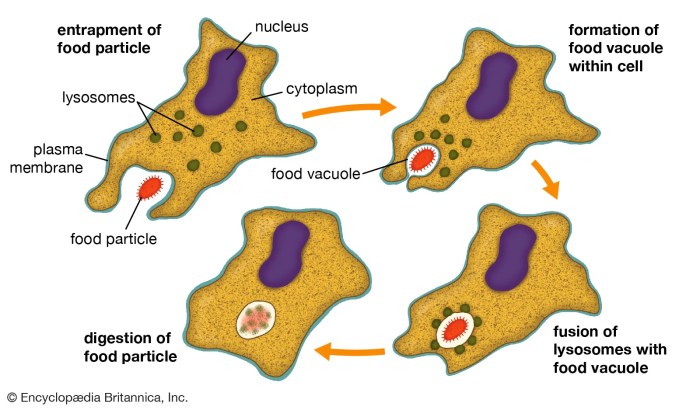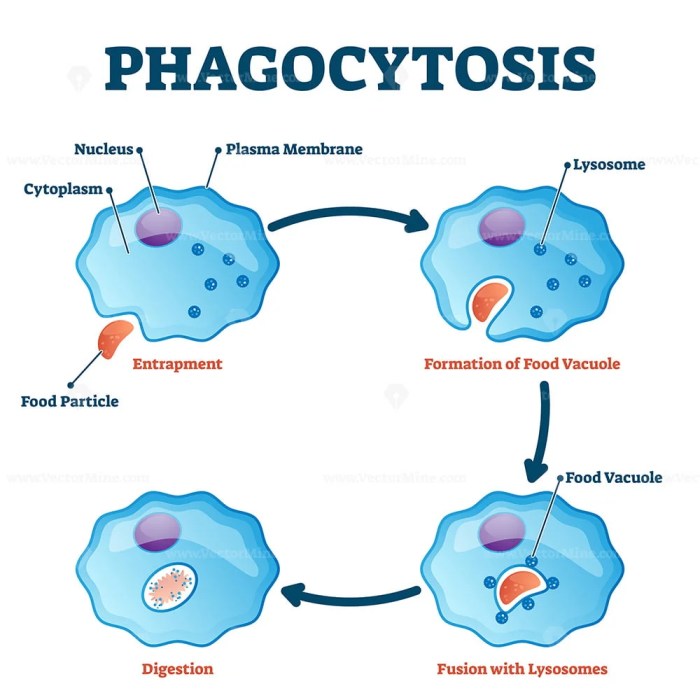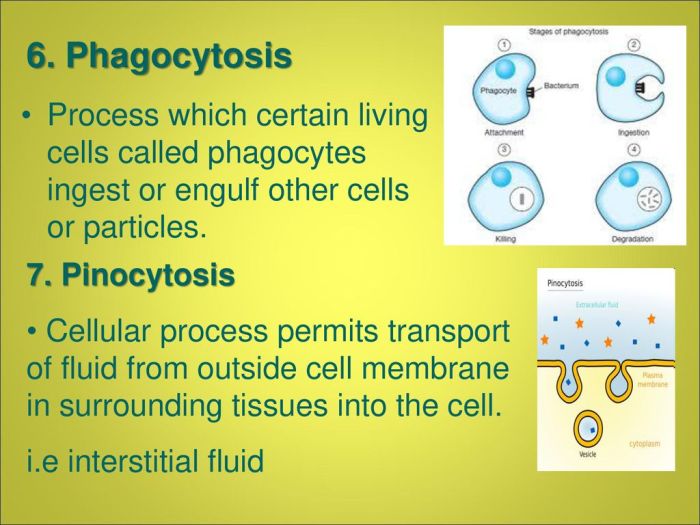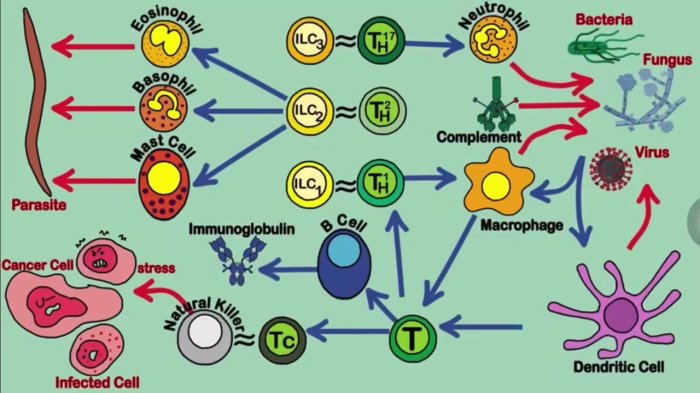Which of the following statements concerning phagocytosis is true? This question delves into the fascinating world of phagocytosis, a process where cells engulf and destroy foreign particles, playing a crucial role in the body’s defense system. As we explore the intricate mechanisms of phagocytosis, we will uncover its significance in maintaining health and fighting infections.
Phagocytosis is a highly orchestrated process involving various types of cells, each with specific roles in recognizing, engulfing, and eliminating pathogens. Opsonins, special proteins, act as molecular bridges, facilitating the interaction between phagocytes and their targets. This intricate process ensures the efficient clearance of harmful substances, safeguarding the body from infections and maintaining overall well-being.
Phagocytosis Process: Which Of The Following Statements Concerning Phagocytosis Is True
Phagocytosis is a fundamental cellular process that enables specialized cells to engulf and internalize foreign particles, including microorganisms, cellular debris, and apoptotic cells.
The mechanism of phagocytosis involves several key steps:
- Recognition:Phagocytic cells recognize foreign particles through receptors on their surface that bind to specific molecules on the particle’s surface.
- Attachment:Once recognized, the phagocytic cell attaches to the particle, forming a tight bond.
- Ingestion:The phagocytic cell extends its membrane around the particle, engulfing it into a membrane-bound vesicle called a phagosome.
- Fusion:The phagosome fuses with a lysosome, a vesicle containing digestive enzymes.
- Degradation:The digestive enzymes within the phagolysosome break down the ingested material into smaller molecules that can be recycled or excreted by the cell.
Cells involved in phagocytosis include:
- Neutrophils
- Macrophages
- Dendritic cells
Opsonins play a crucial role in phagocytosis by coating foreign particles with molecules that enhance their recognition and attachment to phagocytic cells.
Types of Phagocytosis

There are different types of phagocytosis, each with distinct characteristics:
- Heterophagy:The ingestion of foreign particles, including microorganisms and cellular debris.
- Autophagy:The ingestion of a cell’s own components, such as damaged organelles or proteins.
- Micropinocytosis:The ingestion of small particles or molecules through invagination of the cell membrane.
- Phagocytosis of apoptotic cells:The ingestion of cells that have undergone programmed cell death.
Specific examples of phagocytic cells and their targets include:
- Neutrophils:Ingest bacteria and fungi
- Macrophages:Ingest a wide range of particles, including bacteria, viruses, and cellular debris
- Dendritic cells:Ingest antigens from pathogens and present them to the immune system
Phagocytosis and Immunity

Phagocytosis plays a vital role in the immune system by eliminating pathogens and other foreign substances.
- Defense against infection:Phagocytic cells are the first line of defense against invading microorganisms, engulfing and killing them before they can establish an infection.
- Antigen presentation:Phagocytic cells can process and present antigens from pathogens to other immune cells, such as T cells, initiating an adaptive immune response.
- Clearance of debris:Phagocytes remove dead cells, cellular debris, and other waste materials from the body, maintaining tissue homeostasis.
Examples of pathogens targeted by phagocytes include:
- Bacteria (e.g., Streptococcus pneumoniae)
- Viruses (e.g., influenza virus)
- Fungi (e.g., Candida albicans)
Regulation of Phagocytosis

Phagocytosis is regulated by a complex network of signaling molecules and external stimuli:
- Opsonins:Molecules that coat foreign particles and enhance their recognition by phagocytic cells.
- Chemotaxis:Chemical signals attract phagocytic cells to the site of infection or inflammation.
- Cytokines:Proteins released by immune cells that stimulate or inhibit phagocytosis.
- Hormones:Certain hormones, such as corticosteroids, can suppress phagocytosis.
Clinical Relevance of Phagocytosis

Impaired phagocytosis can lead to various diseases, including:
- Chronic granulomatous disease:A genetic disorder characterized by impaired production of reactive oxygen species by phagocytes, leading to recurrent infections.
- Immunodeficiency disorders:Conditions in which phagocytes are dysfunctional or absent, resulting in increased susceptibility to infections.
Therapeutic strategies that target phagocytosis include:
- Antibiotics:Drugs that kill or inhibit the growth of bacteria, reducing the burden on phagocytic cells.
- Immunostimulants:Substances that enhance phagocytic activity, such as cytokines or opsonins.
Phagocytosis has potential applications in medicine, such as:
- Drug delivery:Phagocytic cells can be engineered to deliver drugs directly to target tissues.
- Immunotherapy:Enhancing phagocytic activity can improve the body’s ability to fight infections and cancer.
FAQ Corner
What is the primary function of phagocytosis?
Phagocytosis is the process by which cells engulf and destroy foreign particles, such as bacteria, viruses, and cellular debris, protecting the body from infection and maintaining tissue homeostasis.
What are the different types of phagocytes?
There are various types of phagocytes, including neutrophils, macrophages, and dendritic cells, each with specific roles and functions in the immune system.
How do opsonins contribute to phagocytosis?
Opsonins are proteins that coat foreign particles, facilitating their recognition and binding to phagocytes, enhancing the efficiency of phagocytosis.